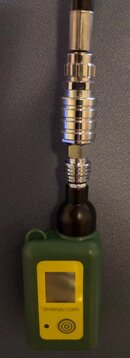think he means this: Aqua Air II hose to Standard Inflator Adapter AA09
Looks like the same thing he linked, except yours is from leisurepro and his was from amazon. It's an adapter so you can use things like the delrin adapter for the scubapro sized low pressure QD hose.
I think I probably will just skip the delrin adapter. My current nitrox analyzer (Maxtec Handi+) came with a similar adapter. The different sizes make it simpler to just not use them. In the case of the maxtec, you just unscrew the ball and replace it with a hose that has a connector for the lp hose. I'm not sure if I like the divenav implementation more or less than that.
Is there any chance divenav or cool hardware could make an adapter for scubapro lpi connectors directly? I'd prefer that to buying a second adapter for the original delrin adapter.
Or better yet, open source a drawing so I could cut one on the cnc lathe at our local hackerspace... eh? nudge nudge, wink wink.
I hope this thing takes off.. at least one LDS owner I've talked to wants to check it out and is hoping to eventually be able to sell the cootoo. I think it could bring CO testing into the mainstream since it will no longer be an extra step, and the device really isn't much more than a nitrox analyzer from analox or maxtec.




